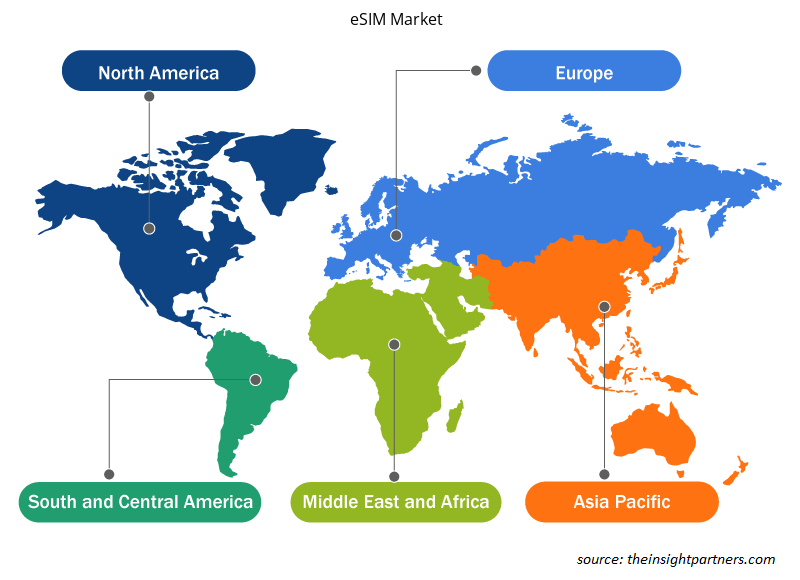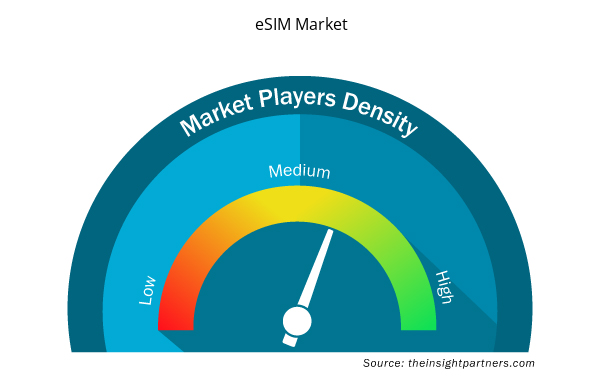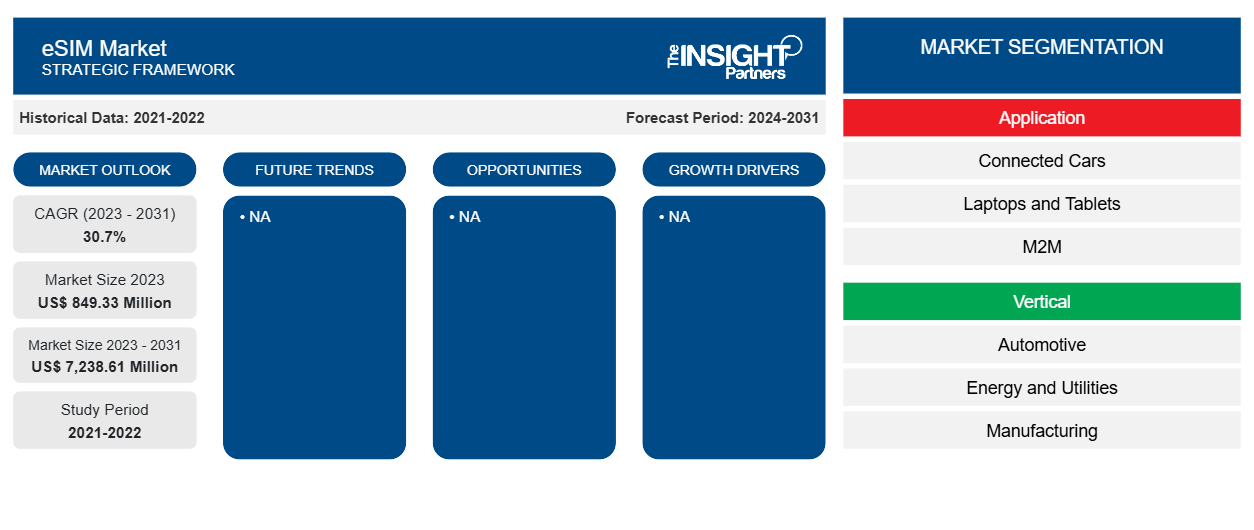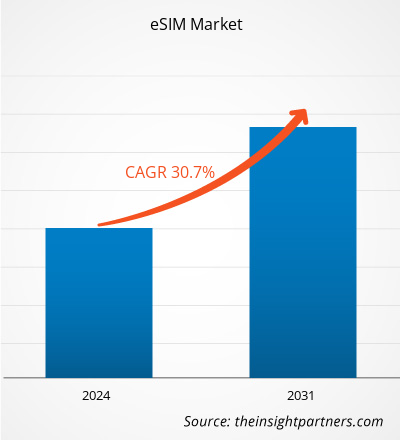预计到 2031 年,eSIM 市场规模将从 2023 年的 8.4933 亿美元增至 72.3861 亿美元。预计 2023-2031 年市场复合年增长率将达到 30.7%。消费者越来越多地采用物联网技术,这可能仍是 eSIM 市场的一个关键趋势。
eSIM市场分析
由于对 M2M 远程 SIM 配置的关注度不断提高,以及消费者对创新消费电子设备的需求不断增长,eSIM 市场正在快速增长。受政府对 M2M 通信有利法规的推动,市场正在稳步扩张。此外,对智能解决方案的需求不断增长,为市场增长提供了有利可图的机会。
eSIM 市场概览
eSIM 或嵌入式用户识别模块是一种数字 SIM 卡,可轻松集成到平板电脑或智能手机等移动设备中。与可移除和更换的传统物理 SIM 卡不同,eSIM 可无缝集成到设备的硬件基础设施中,并可使用各种移动网络配置文件进行精心编程。此功能使消费者能够顺利切换运营商,并轻松启动或调整其移动计划,而无需更换物理 SIM 卡。
汽车行业引入 eSIM 卡后,通过实施附加功能,卡车和汽车可以更灵活地配备蜂窝连接。汽车行业正计划采用下一代联网汽车,支持 GSMA 嵌入式 SIM 卡规范,以改善车辆连接。这旨在提高各种链接服务的安全性。然而,eSIM 在汽车行业拥有巨大的潜力,预计将在预测期内创造增长机会。
定制此报告以满足您的需求
您可以免费定制任何报告,包括本报告的部分内容、国家级分析、Excel 数据包,以及为初创企业和大学提供优惠和折扣
- 获取此报告的关键市场趋势。这个免费样品将包括数据分析,从市场趋势到估计和预测。
eSIM 市场驱动因素和机遇
M2M 远程 SIM 配置日益受到关注,市场青睐
远程配置允许用户将运营商配置文件下载到市场上的 SIM 卡上,并更改或删除用户识别模块 (SIM) 配置文件,而无需实际访问 SIM 卡。eSIM 卡是机器对机器 (M2M) 连接的重要组成部分,包括为所有形式的链接设备提供简单、无缝的移动连接。M2M 需要跨地理区域的广泛连接。eSIM 消除了更换服务提供商的不便,提高了运营效率,并在受控和安全的环境中运行。最新的 eSIM 卡可确保配置文件兼容性,并为游戏玩家在共同基础上进行协作提供主要平台。
智能解决方案需求不断增长——eSIM 带来的机遇
由于物联网基础设施提供的灵活性和连接性,电动汽车、智能城市和智能电表等各种智能解决方案正在全球范围内得到越来越多地使用,从而加速了新兴国家的智能城市和基础设施增长。网络的发展和扩展、包括执行器和传感器在内的硬件组件成本的降低以及新商业模式的出现是引入智能电网部署、自动安全系统、联网汽车等许多服务的一些关键因素。这导致对为客户开发创新智能解决方案的投资增加。因此,在预测期内,汽车、能源和公用事业、制造业、零售业、消费电子、运输和物流等众多行业对智能解决方案的需求不断增加,为 eSIM 市场参与者创造了机会。
eSIM市场报告细分分析
有助于得出 eSIM 市场分析的关键部分是应用和垂直。
- 根据应用,eSIM 市场分为联网汽车、笔记本电脑和平板电脑、M2M、智能手机、可穿戴设备等。M2M 领域在 2023 年占据了更大的市场份额。
- 根据垂直行业,市场细分为汽车、能源和公用事业、制造、零售、消费电子、运输和物流等。消费电子领域在 2023 年占据了最大的市场份额。
eSIM 市场份额(按地区)分析
eSIM 市场报告的地理范围主要分为五个区域:北美、亚太、欧洲、中东和非洲以及南美/南美和中美。就收入而言,由于技术进步,北美占据了 eSIM 最大的市场份额。
预计亚太地区在预测期内将以显着的复合年增长率扩张。该地区的市场分为澳大利亚、中国、日本、印度、韩国和亚太其他地区。华为技术有限公司和三星电子有限公司等主要智能手机参与者已经开发了 eSIM 手机,这加速了 eSIM 在智能手机市场的采用。此外,eSIM 还代表着联网设备 SIM 技术的未来。此外,来自中国和印度等国家的各种 OEM 正在创建 eSIM 解决方案,并在整个生态系统中组建协作开发团队,以创建战术开发路径。例如,2021 年 6 月,eSIM 制造公司 IDEMIA 在印度建立了新的生产工厂,预计将扩大全球 eSIM 的生产能力。据德国数字解决方案公司 Giesecke+Devrient (G&D) 称,到 2024 年底,25-30% 的智能手机将具备 eSIM 功能。然而,与数字化程度不断提高相关的智能手机行业的扩张正在为预测期内的市场创造机会。
eSIM 市场区域洞察
Insight Partners 的分析师已详细解释了预测期内影响 eSIM 市场的区域趋势和因素。本节还讨论了北美、欧洲、亚太地区、中东和非洲以及南美和中美洲的 eSIM 市场细分和地理位置。

- 获取 eSIM 市场的区域特定数据
eSIM 市场报告范围
| 报告属性 | 细节 |
|---|---|
| 2023 年的市场规模 | 8.4933亿美元 |
| 2031 年市场规模 | 72.3861亿美元 |
| 全球复合年增长率(2023 - 2031) | 30.7% |
| 史料 | 2021-2022 |
| 预测期 | 2024-2031 |
| 涵盖的领域 | 按应用
|
| 覆盖地区和国家 | 北美
|
| 市场领导者和主要公司简介 |
|
eSIM 市场参与者密度:了解其对业务动态的影响
由于消费者偏好的不断变化、技术进步以及对产品优势的认识不断提高等因素,最终用户需求不断增加,推动了 eSIM 市场快速增长。随着需求的增加,企业正在扩大其产品范围,进行创新以满足消费者需求,并利用新兴趋势,从而进一步推动市场增长。
市场参与者密度是指在特定市场或行业内运营的企业或公司的分布情况。它表明在给定市场空间中,相对于其规模或总市场价值,有多少竞争对手(市场参与者)存在。
在 eSIM 市场运营的主要公司有:
- 德国电信公司
- 金雅拓
- 捷德公司
- 艾迪米
- 英飞凌科技股份公司
- 恩智浦半导体公司
免责声明:上面列出的公司没有按照任何特定顺序排列。

- 获取 eSIM 市场顶级关键参与者概览
eSIM 市场新闻和最新发展
通过收集一手和二手资料研究后的定性和定量数据来评估 eSIM 市场,其中包括重要的公司出版物、协会数据和数据库。以下是 eSIM 市场的发展和战略列表:
- 2023 年 2 月,Amdocs Ltd 与 Drei Austria 合作推出了一款创新的 eSIM 解决方案,让这家奥地利运营商的客户能够以纯应用程序的体验享受数字 eSIM 技术带来的好处。使用 up³ 应用程序的 Drei Austria 客户现在可以在 Apple、Google、Samsung 等公司生产的设备上管理他们的 eSIM。(来源:Amdocs Ltd,新闻稿,2023 年)
- 2022 年 12 月,Grover 宣布在美国推出自己的移动虚拟网络运营商 (MVNO),供科技租赁客户使用,即 Grover Connect。借助 Grover Connect,美国客户可以轻松激活任何支持 eSIM 的技术设备,不会有任何麻烦。Grover eSIM 在美国结账时可供客户使用,并将在不久的将来推广到其欧洲市场。(来源:Grover,新闻稿,2022 年)
- 2022 年 10 月,Bharti Airtel Ltd 在印度推出了“Always On”物联网连接解决方案。Airtel 的“Always On”解决方案包括双配置文件 M2M eSim,允许物联网设备始终连接到 eSIM 中不同移动网络运营商 (MNO) 的移动网络。Airtel 的解决方案是符合 AIS-140 标准的双配置文件 M2M eSim,最适合车辆跟踪提供商、汽车制造商以及设备在需要无处不在的连接的偏远地区工作的任何用例。(来源:Bharti Airtel Ltd,新闻稿,2022 年)
eSIM 市场报告覆盖范围和交付成果
“eSIM 市场规模和预测(2021-2031)”报告对市场进行了详细的分析,涵盖以下领域:
- 范围内所有主要细分市场的全球、区域和国家层面的市场规模和预测
- 市场动态,如驱动因素、限制因素和关键机遇
- 未来的主要趋势
- 详细的 PEST/波特五力分析和 SWOT 分析
- 全球和区域市场分析涵盖关键市场趋势、主要参与者、法规和最新市场发展
- 行业格局和竞争分析,涵盖市场集中度、热点图分析、知名参与者和最新发展
- 详细的公司简介
- 历史分析(2 年)、基准年、预测(7 年)及复合年增长率
- PEST 和 SWOT 分析
- 市场规模价值/数量 - 全球、区域、国家
- 行业和竞争格局
- Excel 数据集


- Digital Language Learning Market
- Medical Enzyme Technology Market
- Hydrogen Compressors Market
- Data Annotation Tools Market
- Electronic Toll Collection System Market
- Dried Blueberry Market
- Procedure Trays Market
- GMP Cytokines Market
- Vertical Farming Crops Market
- Pressure Vessel Composite Materials Market

Report Coverage
Revenue forecast, Company Analysis, Industry landscape, Growth factors, and Trends

Segment Covered
This text is related
to segments covered.

Regional Scope
North America, Europe, Asia Pacific, Middle East & Africa, South & Central America

Country Scope
This text is related
to country scope.
常见问题
The global eSIM market was estimated to be US$ 849.33 million in 2023 and is expected to grow at a CAGR of 30.7% during the forecast period 2023 - 2031.
The growing focus on remote SIM provisioning for M2M and rising demand for innovative consumer electronics devices among consumers are the major factors that propel the global eSIM market.
The rising adoption of IoT technology among customers is anticipated to play a significant role in the global eSIM market in the coming years.
The key players holding majority shares in the global eSIM market are Deutsche Telekom AG, Thales SA, IDEMIA France SAS, Infineon Technologies AG, and NXP Semiconductors NV.
The global eSIM market is expected to reach US$ 7,238.61 million by 2031.
The incremental growth expected to be recorded for the global eSIM market during the forecast period is US$ 6,389.28 million.
Trends and growth analysis reports related to Electronics and Semiconductor : READ MORE..
The Insight Partners performs research in 4 major stages: Data Collection & Secondary Research, Primary Research, Data Analysis and Data Triangulation & Final Review.
- Data Collection and Secondary Research:
As a market research and consulting firm operating from a decade, we have published and advised several client across the globe. First step for any study will start with an assessment of currently available data and insights from existing reports. Further, historical and current market information is collected from Investor Presentations, Annual Reports, SEC Filings, etc., and other information related to company’s performance and market positioning are gathered from Paid Databases (Factiva, Hoovers, and Reuters) and various other publications available in public domain.
Several associations trade associates, technical forums, institutes, societies and organization are accessed to gain technical as well as market related insights through their publications such as research papers, blogs and press releases related to the studies are referred to get cues about the market. Further, white papers, journals, magazines, and other news articles published in last 3 years are scrutinized and analyzed to understand the current market trends.
- Primary Research:
The primarily interview analysis comprise of data obtained from industry participants interview and answers to survey questions gathered by in-house primary team.
For primary research, interviews are conducted with industry experts/CEOs/Marketing Managers/VPs/Subject Matter Experts from both demand and supply side to get a 360-degree view of the market. The primary team conducts several interviews based on the complexity of the markets to understand the various market trends and dynamics which makes research more credible and precise.
A typical research interview fulfils the following functions:
- Provides first-hand information on the market size, market trends, growth trends, competitive landscape, and outlook
- Validates and strengthens in-house secondary research findings
- Develops the analysis team’s expertise and market understanding
Primary research involves email interactions and telephone interviews for each market, category, segment, and sub-segment across geographies. The participants who typically take part in such a process include, but are not limited to:
- Industry participants: VPs, business development managers, market intelligence managers and national sales managers
- Outside experts: Valuation experts, research analysts and key opinion leaders specializing in the electronics and semiconductor industry.
Below is the breakup of our primary respondents by company, designation, and region:

Once we receive the confirmation from primary research sources or primary respondents, we finalize the base year market estimation and forecast the data as per the macroeconomic and microeconomic factors assessed during data collection.
- Data Analysis:
Once data is validated through both secondary as well as primary respondents, we finalize the market estimations by hypothesis formulation and factor analysis at regional and country level.
- Macro-Economic Factor Analysis:
We analyse macroeconomic indicators such the gross domestic product (GDP), increase in the demand for goods and services across industries, technological advancement, regional economic growth, governmental policies, the influence of COVID-19, PEST analysis, and other aspects. This analysis aids in setting benchmarks for various nations/regions and approximating market splits. Additionally, the general trend of the aforementioned components aid in determining the market's development possibilities.
- Country Level Data:
Various factors that are especially aligned to the country are taken into account to determine the market size for a certain area and country, including the presence of vendors, such as headquarters and offices, the country's GDP, demand patterns, and industry growth. To comprehend the market dynamics for the nation, a number of growth variables, inhibitors, application areas, and current market trends are researched. The aforementioned elements aid in determining the country's overall market's growth potential.
- Company Profile:
The “Table of Contents” is formulated by listing and analyzing more than 25 - 30 companies operating in the market ecosystem across geographies. However, we profile only 10 companies as a standard practice in our syndicate reports. These 10 companies comprise leading, emerging, and regional players. Nonetheless, our analysis is not restricted to the 10 listed companies, we also analyze other companies present in the market to develop a holistic view and understand the prevailing trends. The “Company Profiles” section in the report covers key facts, business description, products & services, financial information, SWOT analysis, and key developments. The financial information presented is extracted from the annual reports and official documents of the publicly listed companies. Upon collecting the information for the sections of respective companies, we verify them via various primary sources and then compile the data in respective company profiles. The company level information helps us in deriving the base number as well as in forecasting the market size.
- Developing Base Number:
Aggregation of sales statistics (2020-2022) and macro-economic factor, and other secondary and primary research insights are utilized to arrive at base number and related market shares for 2022. The data gaps are identified in this step and relevant market data is analyzed, collected from paid primary interviews or databases. On finalizing the base year market size, forecasts are developed on the basis of macro-economic, industry and market growth factors and company level analysis.
- Data Triangulation and Final Review:
The market findings and base year market size calculations are validated from supply as well as demand side. Demand side validations are based on macro-economic factor analysis and benchmarks for respective regions and countries. In case of supply side validations, revenues of major companies are estimated (in case not available) based on industry benchmark, approximate number of employees, product portfolio, and primary interviews revenues are gathered. Further revenue from target product/service segment is assessed to avoid overshooting of market statistics. In case of heavy deviations between supply and demand side values, all thes steps are repeated to achieve synchronization.
We follow an iterative model, wherein we share our research findings with Subject Matter Experts (SME’s) and Key Opinion Leaders (KOLs) until consensus view of the market is not formulated – this model negates any drastic deviation in the opinions of experts. Only validated and universally acceptable research findings are quoted in our reports.
We have important check points that we use to validate our research findings – which we call – data triangulation, where we validate the information, we generate from secondary sources with primary interviews and then we re-validate with our internal data bases and Subject matter experts. This comprehensive model enables us to deliver high quality, reliable data in shortest possible time.


 获取此报告的免费样本
获取此报告的免费样本